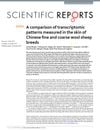TLDR Cellular debris sticks to damaged wool fibers and affects wool cleanliness.
The study investigated cellular debris in wool grease using transmission electron microscopy. It found that cellular debris from the wool follicle, its appendages, and the epidermis was dispersed in wool grease. The debris showed little interaction with undamaged wool fiber surfaces but adhered to damaged fiber surfaces. Additionally, a negative correlation was observed between the protein content of wool washings and the clean wool yield, suggesting that higher protein contamination in wool washings resulted in lower clean wool yield.
59 citations
,
August 1981 in “PubMed” Trichilemmal keratinization is a unique process in hair follicles where the outer root sheath turns into keratin without a specific layer.
 17 citations
,
October 2017 in “Scientific reports”
17 citations
,
October 2017 in “Scientific reports” Fine wool sheep have more genes for wool quality, while coarse wool sheep have more for skin and muscle traits.
Editing the FGF5 gene in sheep increases fine wool growth.
 116 citations
,
May 2013 in “Proceedings of the National Academy of Sciences of the United States of America”
116 citations
,
May 2013 in “Proceedings of the National Academy of Sciences of the United States of America” Hair grows faster in the morning and is more vulnerable to damage from radiation due to the internal clock in hair follicle cells.
 25 citations
,
October 2018 in “PloS one”
25 citations
,
October 2018 in “PloS one” Key genes regulate hair follicle phase changes in Inner Mongolia cashmere goats.
53 citations
,
July 2016 in “Cosmetics” Future hair cosmetics will be safer and more effective.


